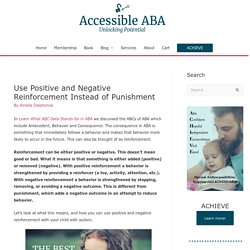

Fret not, this is a page where you could find some constructive suggestions on how to reinforce and/or punish your somewhat problematic teenage child.
As scary and negative as it may sound, reinforcement and punishment could actually be both positive and negative. By positive reinforcement/punishment, it means applying/giving a stimulus to increase/strengthen the chances of a response from your child to result in a desired behaviour. On the other hand, negative reinforcement/punishment means removing/withdrawing a stimulus to decrease/weaken the chances of a response to result in a desired behaviour. Read on to find out more!
[Video] Positive Reinforcement - Tips for teaching and parenting. Positive Reinforcement for Adolescents. By the time children have reached adolescence, their responses are often ingrained, but parental actions can still positively affect adolescent behavior.
Since adolescents are struggling to develop their personal identity and are concerned about their body image, parental support is crucial to help positively frame experiences as learning opportunities. Positive reinforcement remains a powerful teaching tool during these formative years, and we encourage parents to take time to contemplate the ways they can help adolescents mature and become self-reliant. Reinforce mature decisions by allowing increased privileges when adolescent demonstrates increased responsibility. For instance, an adolescent who consistently demonstrates the ability to come home at the requested time might be allowed a later curfew - whereas an adolescent who has not completed requested chores will not be allowed to leave home that evening.Express pleasure at positive adolescent behavior.
How to Reward Your Teen for Good Behavior. Teenagers are young adults who are trying to learn the ways of the world.

When they do something great at school or at home or simply make a healthy decision, parents can give them a reward. The reward does not have to be money, but it is a nice way to say "thank you" or "I'm proud of you. " Use Reinforcement Instead of Punishment - Accessible ABA, Inc. In Learn What ABC Data Stands for in ABA we discussed the ABCs of ABA which include Antecedent, Behavior and Consequence.

The consequence in ABA is something that immediately follows a behavior and makes that behavior more likely to occur in the future. This can also be thought of as reinforcement. Reinforcement can be either positive or negative. This doesn’t mean good or bad. What is Negative Reinforcement?
[Video] What is Positive Punishment? Real-Life Examples of Positive Punishment. “Positive” and “punishment” seem like two words that you wouldn’t use together.

However, positive punishment will make complete sense once you learn the definition and explore some examples of positive punishment. Review how positive punishment is different from negative punishment and which is more effective. Understanding Positive Punishment “Positive punishment” might seem like an oxymoron. However, if you expand your thinking beyond positive to mean something “good” to positive meaning to add something, then a positive punishment makes a lot of sense. Difference between positive and negative punishment. Examples of positive and negative punishment.